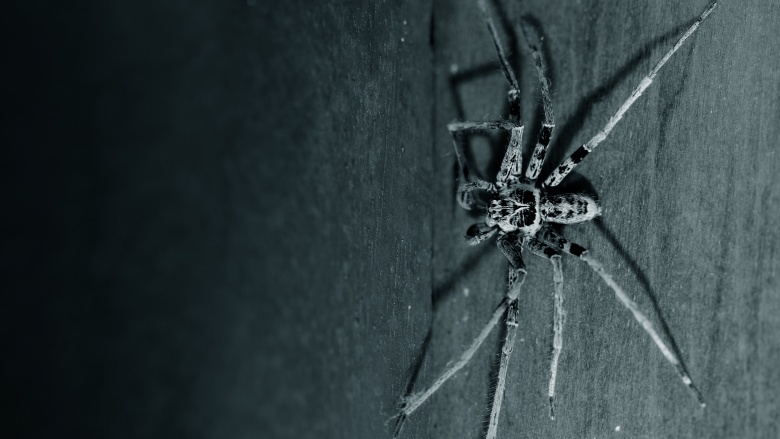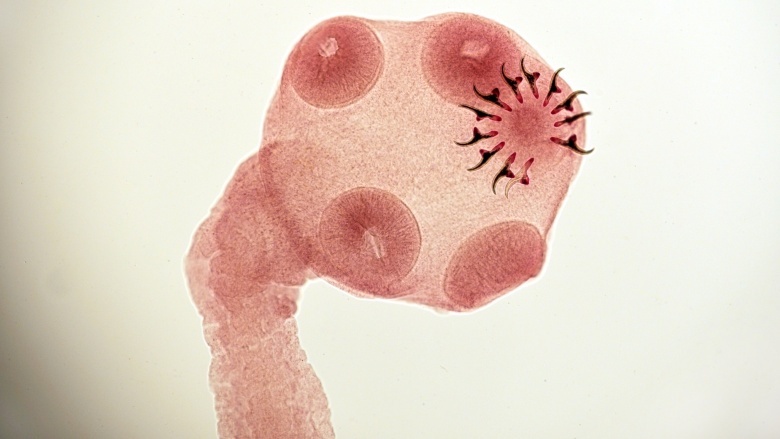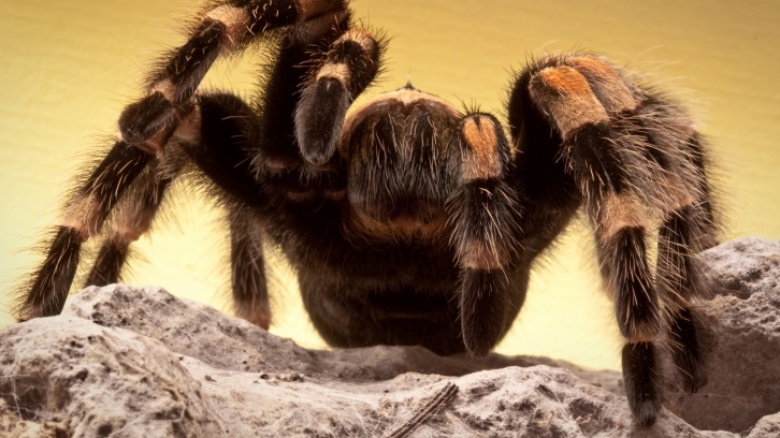Real-Life Animal Horror Stories
Everybody loves animal monster movies and horror stories. Think Jaws, Cujo, or The Birds. But those are just films. Animals aren't really that scary, right? Well, wrong — real-life animals are pretty terrifying, too. After all, most are stronger and faster than humans, and some are packing pretty serious poisons. And if you ever cross these creatures while they're in a mood, you might find yourself in the middle of a real-life animal horror story.
Tapeworm on the brain
Who can forget the chestburster from Alien? It's one of the most disgusting creatures in cinematic history. The concept of something slithering around your insides is horrific. Unfortunately, it's also 100% realistic (minus the actual chestbursting part).
In 2008, a 50-year-old British man suddenly began experiencing seizures and major headaches. He started smelling weird smells, and stranger still, he began having unexplained flashbacks to really old memories. Worried about his brain, the man sought medical advice, but the doctors were stumped. Eventually, they gave him an MRI and noticed some "ring-like patterns" on the right side of his brain. Over the course of four years, the rings moved from one side of his brain to the other. Finally, in 2012, doctors opened up his skull and found a 1-centimeter-long tapeworm.
When doctors examined the worm, they discovered it was a species called Spirometra erinaceieuropaei, and it was the first of its kind to show up in the UK. Even weirder, these particular tapeworms don't usually end up inside people. However, doctors surmised the man might've picked up the tapeworm from infected meat or water on a trip to China. But even so, how did it live in a human brain for four years? Well, this kind of worm absorbs nutrients through its skin, nutrients like fat. And as New Scientist explains, "Brain tissue is rich in fatty acid." Delicious.
Jack versus the wolverine
Around 1979, a trapper named Jack was living near Nome, Alaska, in the Kigluaik Mountains. According to writer Larry Kaniut, Jack was a loner who'd set a series of traps throughout the region. One day, he was trudging through the snow, checking his snares, when he shot a few ptarmigans for dinner. However, Jack didn't notice the birds were leaving a blood trail in the snow. And he definitely didn't see the wolverine sniffing at the blood.
Later that day, a huge storm savaged the mountain, forcing Jack to take cover under a nearby ledge. As he slept, the wolverine crept into Jack's hiding spot and grabbed the birds. Startled, Jack accidentally scared the critter. Feeling trapped, the wolverine attacked, slashing at Jack's hands and face. Now, wolverines have been known to kill polar bears, so a measly human wouldn't be much of a challenge. Making things worse, one of the wolverine's claws got snagged in the zipper of Jack's coat, causing the terrified creature to go into lawnmower mode. The wolverine cut Jack to the bone before its claw finally came loose. With the birds in its mouth, and no appetite for human flesh, the wolverine took off, leaving Jack to bleed to death.
Needing medical attention, Jack staggered through the blizzard, back to his cabin. Dizzy and faint, he sewed up his wounds before collapsing on his bed. Jack spent the next several days lying in his cabin, waiting for help. Eventually, a pilot stopped by and found the trapper in critical condition. Fortunately, Jack made it to the hospital in time, although his hands would always look like he'd battled a buzz saw. Which, he basically did.
The legend of the Custer Wolf
Some called him the "gray devil of the desert." Others called him "the master criminal of the animal world." Most called him the Custer Wolf because he prowled around the hills of Custer, South Dakota. But he seemed more than just a mere wolf — he was like a murderous ghost, here one moment and gone the next. For nine years, the Custer Wolf killed and maimed cow after cow, seemingly for pleasure. According to reports, he would break legs and bite off tails, just for spite. Some believed he was trying to get revenge for his murdered mate. Soon, the bad dog had a $500 bounty on his head. Still, no one could catch him — the Custer Wolf had a supernatural knack for avoiding traps and poisons.
Desperate, the US government brought in a professional hunter named H.P. Williams, and in March 1920, he set out into the wilderness to kill the beast. In order to fool his prey, Williams covered his shoes with a scent that would trick the gray devil into thinking a she-wolf was nearby. But the creature was too savvy, and on more than one occasion, it escaped from Williams' traps.
Unfortunately for the Custer Wolf, however, he eventually stepped into a trap he couldn't escape. While he managed to pull it out of the ground, he couldn't pry the jaws off his paw. Williams was then able to track the wounded animal and put it out of its misery. When Williams approached his quarry—the animal he'd been hunting for over five months—he found the dreaded Custer Wolf was actually an elderly, undernourished animal with bad teeth and an old, white coat. That like unmasking Jason Voorhees and finding out he's your cranky grandpa.
Attack of the killer racoon
Raccoons seem like cute critters, but in reality, they're nasty fiends that can rip you apart. And raccoons infected with rabies are like creatures possessed. That's something a woman named Michelle found out the hard way. As she told This American Life, while walking in the New York countryside one wintry day, Michelle spotted a raccoon in the distance. After observing the creature for a few moments, she realized it was charging at her — snarling, hissing, and ready to attack. Terrified, Michelle tried to escape, but there's no outrunning a raging raccoon.
The 30-pound creature caught up with Michelle and jumped onto her leg. Thankfully, she was wearing a lot of winter clothing, making it difficult for the raccoon to latch on with its teeth. Michelle battled the little devil for a few seconds, suffering several bites, before finally pinning it in the snow with her hands. As she held the angry animal down, she managed to get her phone out of her pocket and call her husband for help. Moments later, both her husband and adult son arrived. They quickly weighed the raccoon down with a heavy branch, so it couldn't attack again. It was obvious the creature had rabies, so Michelle's husband tried to kill it with a tire iron. When that failed, their son gave it a try, whacking the raccoon for five minutes until it died.
But this was just the beginning of Michelle's horror story, because if there's anything more destructive than a rabid animal, it's human bureaucracy and incompetence. Michelle called two separate health departments, asking for help. Unfortunately, they were both closed because it was the weekend. She then phoned a nearby hospital and was told she had up to two weeks to get the necessary shots. Michelle thought she had plenty of time, but on Monday, a health official called her with some horrible news: Michelle didn't have 14 days. She had 72 hours ... from the first bite. In other words, she had to get a shot by the end of the day or die a gruesome death.
With the clock ticking, she rushed to the ER, but the staff said they couldn't help, since Michelle was from a different county. Michelle begged for assistance, and the doctors finally agreed ... only they administered the shots in the wrong part of her body. Frantic, Michelle called about ten more doctors, none of whom were willing to help ... until she threatened to call the State Board of Health, since they were effectively murdering her. That finally got things moving, and Michelle got her shots. Of course, she probably gets a little anxious when walking in the woods now.
The tarantula train
James Payn was a hobo from Liverpool, England, and in 1897, he was making his way across the US. Like a lot of hobos, Payn was skilled at slipping into freight cars and sneaking free rides around the country. Payn knew he'd get in trouble if he were caught, but he was willing to take that risk. However, if Payn had only known what would happen to him in one creepy train car, he probably would've decided to walk instead.
While freighthopping one fateful day, Payn wound up in a car full of bananas. He shut the car door and settled down for a nap, but moments later, he felt furry little legs skittering up and down his face. Horrified, he lit a match and found the bananas were crawling with tarantulas. And now, these massive spiders were crawling up and down his body. Terrified, Payn yanked at the car door, trying his best to hurl it open. Unfortunately, the door was sealed tight .. .and the spiders were everywhere. Eventually, the terror proved too much, and Payn fainted. When he awoke, he was in an Oregon hospital bed, but he was far from okay. According to newspapers of the day, the hobo had gone stark raving mad. Becoming a spider motel will do that to the best of us.
The wolves of Paris
While the Custer Wolf terrorized the US by itself, some killer canines prefer bringing their friends along. In 15th-century France, Paris was terrorized by a murderous wolf pack led by a monster named Courtaud, which means "bobtail" or "stump-tail." So it's probably safe to assume this wolf lacked, well, a tail. And perhaps he was so angry about his missing appendage, he decided to take his wrath out on all of humanity.
Or, as is more likely the case, Courtaud and his wolf pack were incredibly hungry. In the 1430s, Paris was hit with some pretty savage winters. Desperate for food, the wolves moved into the City of Lights, eager to try the tasty French cuisine. Between 1436 and 1440, the wolves killed between 60 to 80 people, and most of these assaults were led by Courtaud. The animals would slip through cracks in the city walls and chase down any unlucky human who crossed their path.
The pack raided Paris multiple times before the citizens finally fought back. In 1439, the Parisians lured the wolves into the public square in front of Notre Dame, and that's where they sprang their trap. The humans surrounded the wolves and began hurling rocks and stones. Soon, the wolves were dead, and Courtaud's body was paraded through the city.
The scientist who recorded his own death
Mad scientists are a pretty common horror movie trope. Characters like Dr. Frankenstein or Seth Brundle are constantly pushing the bounds of science, putting life and limb on the line in the name of discovery. Karl P. Schmidt was like that, too. A herpetologist who worked at esteemed facilities like the American Museum of Natural History in New York and the Field Museum of Chicago, Schmidt was an expert on all things reptilian, and sometimes people would send him strange snakes for identification.
On September 25, 1957, the Lincoln Park Zoo sent over an interesting serpent for Dr. Schmidt to examine. Schmidt determined it was a boomslang, a venomous African snake. But as he examined the animal, Schmidt got careless, and the boomslang bit him on the hand. Instead of going to a hospital, though, the doctor decided to go home. He didn't think the boomslang had delivered a fatal blow (or even could, for that matter). Plus, he knew that boomslang antivenin could only be found in Africa. But most importantly (and most creepily), Schmidt wanted to record his symptoms in his diary.
Upon returning home, Schmidt jotted down every little thing that happened to his body. He wrote about how get the chills, followed by a high fever. He mentioned how his gums were bleeding, how he was urinating blood, and how he vomited his dinner of milk toast. Schmidt kept up his journal for 15 hours, until he collapsed to the floor. As you've probably gathered by now, Schmidt was 100% wrong about the boomslang — it's one of the deadliest snakes in the world. Tragically, he died on September 26, due to respiration paralysis. When doctors performed an autopsy, they found that Schmidt had been bleeding from his lungs, kidneys, heart, and brain.
The kraken rises
There's no creature quite as terrifying as the giant squid. It's the ten-legged spider of the sea, complete with a monstrous beak. The giant squid has long been a fixture of ocean horror stories, even showing up in 20,000 Leagues Under the Sea. But giant squid attacks aren't just fiction. In fact, a real-life attack in the 19th century actually helped scientists understand these mysterious creatures a bit better.
In 1873, a fisherman named Theophilus Picot was fishing in Conception Bay, off the coast of Newfoundland. As he was rowing along, he noticed something strange in the water. At first, he wondered if it was the debris from a wreck, but whatever it was, it was gigantic. Curious, Picot poked the object with his oar ... and that's when the kraken came to life. According to Skulls in Stars, the squid smacked the underside of Picot's boat with its massive beak. It then wrapped around the vessel with its slimy tentacles, intent on dragging Picot into Davy Jones' locker. Thinking fast, the fisherman grabbed an ax and began hacking away at the tentacles, forcing the now-amputated sea monster to swim away.
One of these tentacles was preserved in a vat of brine and given to Scottish geologist Alexander Murray. It was the first time a giant squid tentacle had been studied up close by scientists. When Murray examined the appendage, he found it to be 17 feet long, but there's also the real possibility that the tentacle was originally even longer. Most likely, it had shriveled up due to the brine before Murray got a chance to measure it. What's more, Picot claimed that some of the tentacle had been chopped off during the battle. The fisherman claimed it was originally over 30 feet long.
The vengeful tiger
It was December 1997, and Vladimir Markov was in trouble. A beekeeper-turned-poacher, Markov was hunting to make ends meet in the Russian province of Primorye. Unfortunately for Markov, he'd made a serious enemy. While poaching, he'd stumbled across a Siberian tiger—a big cat that often weighs over 500 pounds and cares not for puny human guns. Markov shot at the feline, but the tiger managed to escape. Markov then added insult to injury by stealing the tiger's kill. Big mistake.
Days later, Markov was found dead, ripped apart and eaten by an angry cat. The grisly scene was reported to Yuri Trush, the head of an anti-poaching unit called Inspection Tiger. Normally, Trush protected these endangered animals, but this time, Trush was sent to kill the man-eater. After arriving at the scene of this horror story, Trush deduced the tiger had found Markov's cabin while the poacher was out hunting. The cat then proceeded to destroy everything with Markov's scent on it. The tiger chewed up his tools and cooking utensils, and even tore down his outhouse. The tiger then waited hours for Markov to return, and when the unlucky poacher showed up, the cat took its revenge.
But the tiger didn't stop with just one guy. On one occasion, it broke into a man's house, dragged his mattress into the snow, and rested on the bed, comfortably waiting for its victim to arrive. Ultimately, this serial killer cat claimed at least three lives before it was stopped.
Eventually, Trush and his team found the tiger, but the man-eater wasn't going down without a fight. The big cat charged Trush, who managed to fire two shots before he was knocked into the snow. However, Trush only suffered a few wounds because two of his comrades emptied their rifles into the tiger, finally killing the monster cat.








